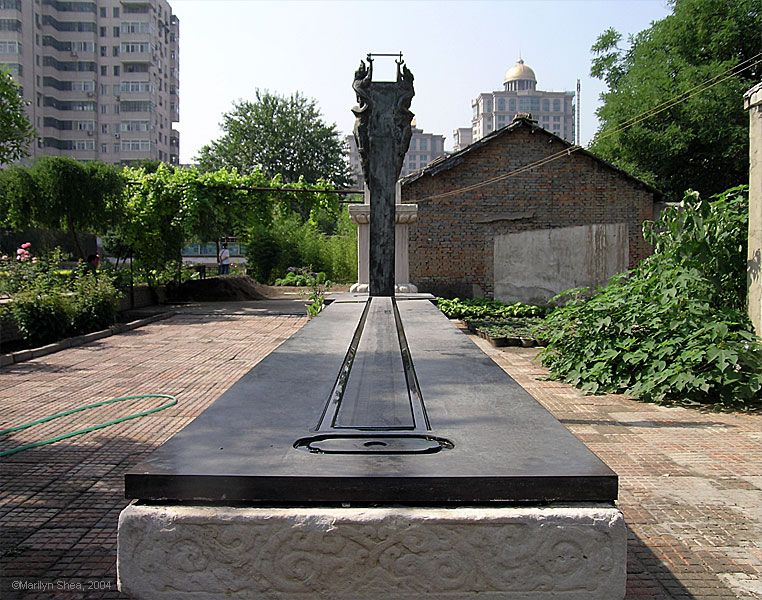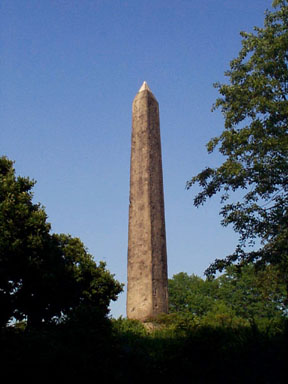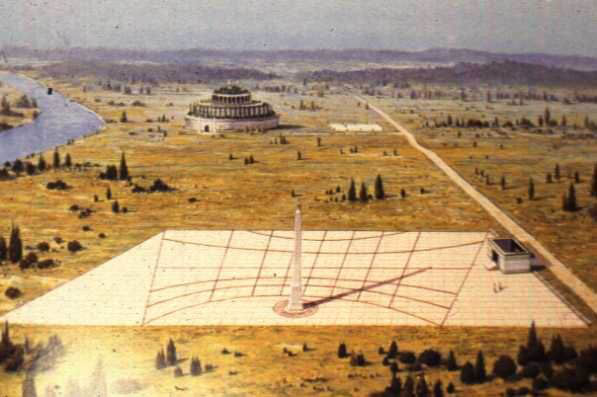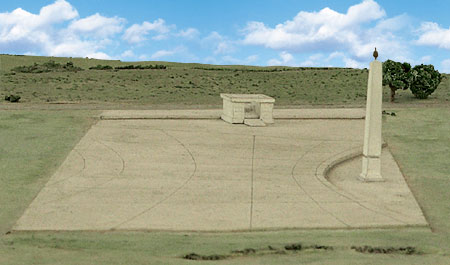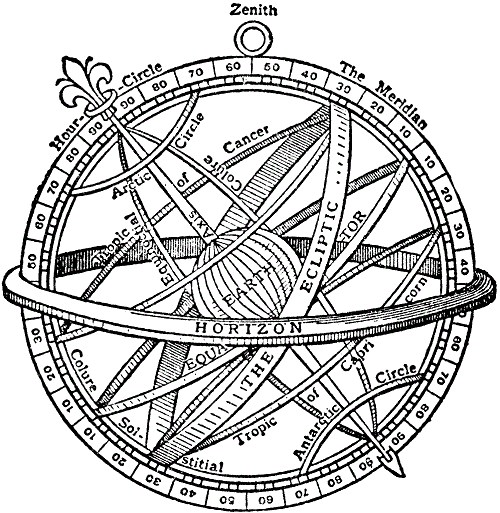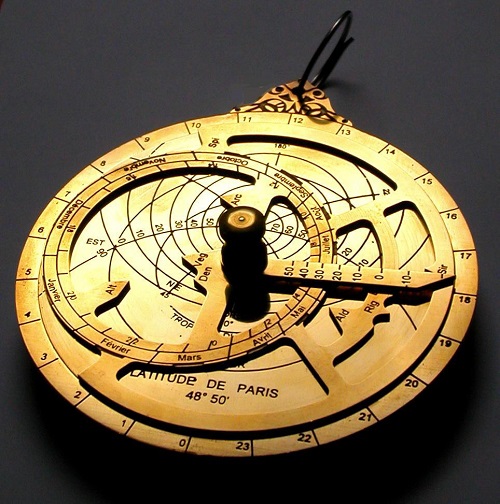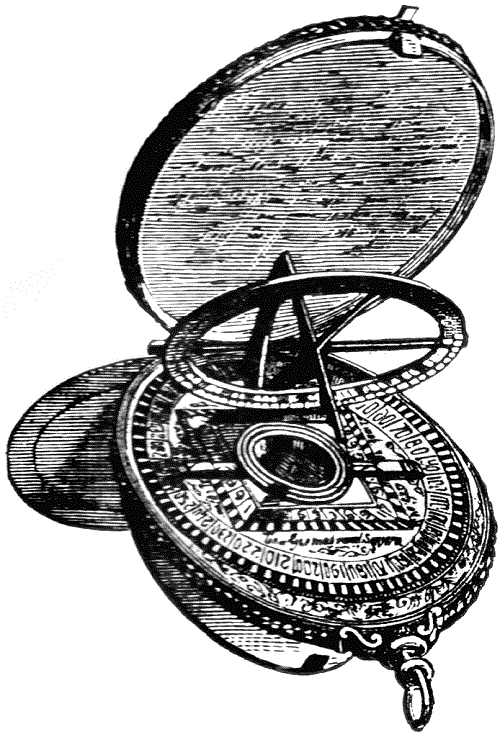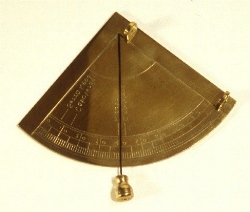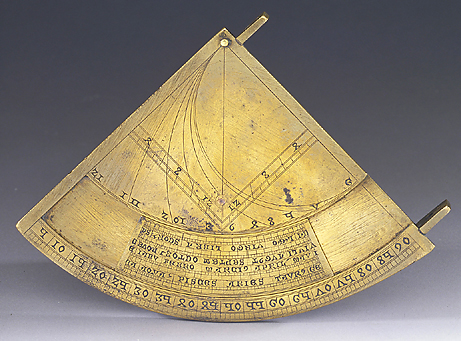Dodwell: The Obliquity of the Ecliptic
CHAPTER 2 THE USE OF THE GNOMON IN ANCIENT AND MEDIAEVAL OBSERVATIONS; AND THE ERRORS OF OBSERVATION WITH THIS INSTRUMENT [note from the Setterfields: we have found illustrations of the instruments mentioned by Dodwell in this chapter and have linked them as a group below the entire text so as not to disturb the flow of the text itself. After each set of pictures for each instrument there is a 'back to text' return link if you wish to view them as you read instead of after you have finished the chapter. They are linked with the FIRST time each instrument is mentioned.] The most ancient instrument, and the one most frequently used for measuring the mid-day altitude of the sun at the summer and winter solstices, chiefly for the purpose of determining the date of the solstices, was the ordinary or plain gnomon, which was a vertical pillar, or column, fixed on a horizontal surface. The length of the shadow cast by the sun was measured, and from this the sun’s altitude was calculated. “For making the more considerable observations, both the ancients and moderns have made great use of it (the vertical gnomon), especially the former, and many have preferred it to the smaller quadrants, both as more accurate, easier made, and more easily applied.” Hutton, Philosophical and Mathematical Dictionary 1815. Vol. 1. Article, “Gnomon”. Out of 85 observations, from 1100 B.C., to 1650 A.D., the whole of the Chinese observations, and the great majority of the others, including Hindu, Greek, Arabian, Persian and mediaeval European observations, were made with the vertical gnomon. In many cases, where other instruments were used, such as by Greek astronomers at Alexandria, and later by some of the Arab and mediaeval European observers, they were supplementary to the vertical gnomon, which was also in use. It is, therefore, chiefly to the errors of this instrument that our attention is directed. A circumstance, which complicates some of the observations, is that the ancient observers did not correct their observations for refraction, parallax and the sun’s semi-diameter. The latter correction is required because the edge of the shadow, cast by the gnomon, corresponds to the upper edge of the sun, and not to its centre. In certain cases, however, instead of the ordinary or plain gnomon casting a shadow, one was used having a metal plate at the top, pierced with a hole. Through this the sun cast a circular spot of light on the horizontal surface. The centre of this spot of light was measured, and gave the angle, [which] correctly referred to the sun’s centre. Nevertheless, a correct result was obtainable with the shadow-casting gnomon if both summer and winter solstices were observed; because the true double angle of obliquity is given by observation of the sun’s upper edge on both occasions, affected only slightly by very small differences of refraction. When only one solstice was observed, however, as in the observation by Pytheas of the summer solstice at Marseilles in 326 B.C., it is necessary to apply the correction for the sun’s semi-diameter to his recorded observation. Very often, the ratio of the height of the gnomon to the length of the shadow, reduced, when possible, to whole numbers, or to whole numbers and fractions, was given, in preference to the angle itself. Thus, Strabo, in speaking of the latitude of Alexandria, determined when the sun was on the celestial equator, says that: “At Alexandria, the relation of the gnomon to the shadow on the day of the equinox is as 5 to 3.” It is a striking coincidence that when the latitude of Alexandria is calculated from these figures, after allowing for refraction, parallax, and correction from the sun’s edge to the centre, we get the exact latitude of the Museum of Alexandria, where the observations were made, viz. 31° 11’ 42” N. Pliny (70 A.D.), in his Natural History, Book II, Chapter 72, similarly gives the ratio in whole numbers for Rome, for he says that at Rome, at the time of the equinoxes, the shadow is to the gnomon as 8 is to 9. From this ratio, after allowing for refraction, parallax, and correction from the sun’s edge to the centre, we get for the latitude of Rome 41º 52’ 07” N, which is only 1’ 26” less than the latitude of the Capitol at Rome. Whole numbers with a fraction, however, are given by Strabo for the observation, made by Pytheas, of the mid-day shadow of the sun at the summer solstice at Marseilles about 326 B.C. The ratio of the height of the gnomon to the length of the shadow is given by Strabo as 120 to 41 4/5. Ptolemy gives the ratio as 60 to 20 5/6 or 120 to 41 4/6. Concerning this, R.T. Gunther, in his account of Ancient Surveying Instruments (Early Science in Oxford, Vol. 1, p. 330), says: “About 326 B.C., in preparation for a voyage of discovery which ended in the finding of our island of Britain, Pytheas sailed from Phocoea to Marseilles. There he erected a large gnomon divided into 120 parts, and fixed its latitude with a result that seems almost incredibly accurate, for applying the sun’s semi-diameter, which he omitted, the latitude he obtained differs not more than one minute from the true latitude of Marseilles Observatory”. These and many similar results from Chinese and other sources, by the substantial accuracy of the latitudes determined with the vertical gnomon, give abundant testimony that this instrument, in the hands of experienced observers in ancient and mediaeval times, was capable of giving results close to the truth, when certain corrections, omitted by ancient observers, are applied to them. It is of interest here, as showing the familiarity of the ancient people with the use of the vertical gnomon, to mention its wide use for domestic and other purposes in ascertaining the time of day. In Becker’s Charicles, illustrating the private life of the ancient Greeks, it is stated that the gnomon was, unquestionably, the most ancient means of measuring the time of day. The shadow which it cast was measured in feet. It is seldom mentioned except in reference to the hour of supper or of the bath. For the former a shadow ten or twelve feet long was assigned, and for the latter a six-feet shadow is spoken of. It is therefore probable that the gnomon was usually constructed so as to throw a shadow about 12 feet long shortly before sunset, for this was the time at which the supper, or chief meal, usually took place. The hour of bathing was that preceding the chief meal. In Charicles, in a description of a wedding, the sun had sunk half way from the meridian, while preparations were still being made in the house of the bride’s parents. The mother, later on, gives warning that the evening will soon be approaching, and requests a female servant to ascertain the time, “Go, Menodora, and measure the shadow on the sun-dial (gnomon) in the garden.” “We have the clepsydra (water-clock) here,” interposed Chloris: “see how much water there is left in it; it will run off once more before sunset.” “I am sure she’s wrong,” said Cleobule: “It must be later.” Mendora, however, returned with the assurance that the shadow was only eight feet long, and therefore wanted some time yet to evening. From this customary use and measurement of the shadow of the gnomon in ordinary civil life, we may be sure that for scientific purposes the length of the shadow was carefully measured by the ancient astronomers. The most ancient observation of the inclination of the earth’s axis, or obliquity of the ecliptic, which has been preserved, has been generally attributed to the celebrated prince of China, Chou Kung, brother of Wu Wang, (founder of the Chou Dynasty), who is renowned in China through all the succeeding centuries for his wise legislation and interest in astronomical science. It was made at Loyang, in the province of Honan, China, in about 1100 B.C. This observation was made with a vertical gnomon, 8 feet high. A height of 8 feet was the standard height of the gnomon in China, and this was fixed by law, on account of the confusion caused by varying heights of gnomons. The gnomon, in different forms, also goes back to very ancient times in Egypt, even as far back as the 15th century B.C. In addition, the Egyptian obelisks, and even the Great Pyramids themselves, were, for practical purposes, essentially gnomons on a gigantic scale. The most ancient obelisk still standing in Egypt, (68 feet high), is that of Senusert I of the XII Egyptian Dynasty at Heliopolis. This dates back to about 2050 B.C. The Roman Emperor Augustus, at the beginning of the Christian Era, followed the example of the Egyptians in using an obelisk 75 feet high, which he had removed from Heliopolis to Rome, “to mark the shadows projected by the sun.” Pliny, who mentions this fact, also says that “The name of obelisks signifies that they are sacred to the sun; it is the image of the sun’s rays which the obelisk reproduces.” This obelisk was erected in the Campus Martius at Rome, and was one of those previously erected by Psamtek I of the XXVI Egyptian Dynasty at Heliopolis. It is now situated on Monte Citorio, near the present Italian House of Parliament. The shadows of the sun were cast upon a level stone corresponding in size to that of the obelisk. They were measured with a brass scale, inserted in the stone, and the length of the days and nights was thus determined, together with the solstices. As the summer solstice approached, the midday shadow decreased little by little, and afterwards increased again; and the opposite effects were observed at the winter solstice. Manilius, the mathematician, in order to obtain more exact observations, fixed on the apex of this obelisk a golden ball, which cast a dense black circular shadow on the pavement. The centre of this could be easily and accurately measured. This form of gnomon, with a terminal ball, is found depicted on medals of the time of Philip of Macedon (359 B.C.); and this arrangement, which was common at Rome, is believed to have been introduced into Greece by Menelaus, King of Sparta, about 1180 B.C. Manilius added these words, concerning his measurements: “This observation now for nearly 30 years is not consistent, either through the discordant course of the sun itself, and some change in the sky, or through some change in the universal earth, by which it has moved away from its centre, as I have detected myself, and I hear of also in other places.” This is a remarkable statement, and constitutes the first recognition of a progressive change in the obliquity of the ecliptic. It also confirms the accuracy obtainable with the vertical gnomon, in the hands of an ancient astronomical observer. The use of the gnomon also extended far into the past among the astronomers of Chaldea; and Herodotus says that it was from the Chaldeans that the early Greek astronomers learnt the use of the gnomon and the polos. The polos was a later development of the gnomon. It was like a basin, in the centre of which stood the vertical staff, or gnomon, and on it the twelve hours of the day were marked with lines. The sun’s altitude was also measured with it. The gnomon, in some of its forms, was called by the Greeks a “skiotheron” (shadow-taker), or “helioptropion,” i.e., an instrument for indicating the turning of the sun at the solstices. It was furnished with measuring marks, and was used to show “the solstices, the times, the seasons, and the equinox.” Not only the Chinese and the Greeks, but the ancient Hindus also used the gnomon for similar purposes. Vitruvius (about 30 B.C.) enumerates more than 10 different forms of the gnomon; and while some, used as sun-dials, were portable, others attained considerable dimensions, up to 20 to 30 feet in height. The highest gnomon, if we except the Great Pyramids of Egypt, was that of Ulugh Beigh; it was used at his Observatory in Samarkand in 1437 A.D., and was 180 feet high. In addition to the gnomon, circular instruments were used by Greek astronomers from about 300 B.C., especially by the most famous of those associated with the Museum of Alexandria, viz., Timocharis, Eratosthenes, Hipparchus and Ptolemy. These were the armilla, the astrolabe, and the quadrant. The armilla and the astrolabe were divided into 360 degrees, and the quadrant into 90 degrees. It is said that the larger instruments of this kind were subdivided to every 10 minutes of arc. This would permit of still closer measurement by estimation of fractions of the subdivisions. The simplest form of the armilla consisted of a large copper ring, graduated with degrees and subdivisions, and mounted vertically in the meridian. A plumb-bob was used for assuring verticality. Within it a second ring rotated in the same plane. This carried two diametrically opposite pins, with pointers for reading the circle. The altitude of the sun at noon was measured by turning the inner ring until the shadow of the upper pin fell centrally on the lower one. It is clear that the Greek astronomers at Alexandria did not restrict themselves to any one instrument, but used several that were available for various kinds of observation. It has been said that “their development of geometry and trigonometry, their invention of well-designed instruments, and their measurement and re-measurement of celestial objects, enabled them to test their carefully formulated theories of the solar system.” Although circular instruments came into use at this period, enabling altitudes of the heavenly bodies to be read off directly from these instruments, without calculation, nevertheless, the very great majority of solar observations of ancient times were made with the vertical gnomon. Ptolemy, known as the “prince of astronomers,” who made astronomical observations at Alexandria from 127 A.D. to 151 A.D., invented a notable improvement of the gnomon. This was called Ptolemy’s Organon Parallactikon, or Regula Ptolemaica, afterwards called Ptolemy’s Rules, or Triquetrum. This instrument was a vertical post, carrying two hinged arms. The shorter upper arm was hinged at the top of the post. The longer lower arm was hinged at a distance from the top exactly equal to the length of the upper arm. The lower extremity of the upper arm slid along the lower arm, and carried a pointer, with which the scale marks in the lower arm read. This arrangement formed an isosceles triangle, the equal sides of which were both 60 divisions in length; the scale divisions of the base enabled the angle at the vertex to be obtained very simply from Ptolemy’s “table of chords.” Ptolemy used the apparatus for measuring the zenith distance of the moon at Alexandria. A large foresight to take the entire disc of the moon, and a small backsight, were used. Gunther, in describing this instrument, points out that “in after years, with Ptolemy's own instrument, the Triquetrum, Copernicus made those measurements with which he overthrew the Ptolemaic System, and gave us a new idea of the Universe.” The Triquetrum used by Copernicus was 8 feet in height. It was made of pine wood, and divided by ink marks, the two equal arms into 1000 parts, and the long rule into 1414 parts. In illustration of the accuracy of this instrument, it is to be mentioned that the obliquity of the ecliptic obtained from the observations made by Copernicus, after allowing for modern corrections for refraction etc., is within 23 seconds of arc, and that which is similarly obtained from Ptolemy’s observations of the moon, is within 15 seconds of arc of the true value. Although the ancient astronomers measured only the length of the shadow cast by the gnomon, and calculated the altitude of the sun without correcting for refraction, parallax, or the sun’s semi-diameter, they nevertheless took great care to ensure the verticality of the gnomon, and the horizontality of the surface on which the shadow fell. They also measure the length of the shadow with considerable precision. It is easy to apply the corrections they omitted; and the substantial accuracy of the latitude, which are then derived from their observations, proves that their solar observations were not affected by gross errors, as has been sometimes supposed, but are of a higher order of accuracy than has been generally admitted. Let us now consider the means which they employed to obtain the best results from their standard instrument, the gnomon. In the first place, verticality was effected by the use of the plumb-line, which was a well known accessory used in ancient astronomical observations. Dr. Breasted describes the Egyptian “Merkhet,” used for orienting temples from times earlier than 2000 B.C., and onwards. It consisted of a sight vane made from the middle rib of a palm leaf, and a plumb-line suspended from an ivory support. It is also known that in the stellar records of the tombs belonging to the XX Dynasty in Egypt, an observer is shown making an astronomical observation with an instrument furnished with a plumb-line. The plumb-line, kept taut with a small leaden plummet or plumb-bob, thus goes back to the earliest times. In the description of Ptolemy’s Astrolabe it is stated that “when an observation was made, the instrument was kept vertical by a plumb-line.” In China the most ancient astronomical classic book, the Chou Pei, parts of which go back to 1100 B.C., does not mention the use of a plumb-line, but instructions are given for setting up the gnomon (Pei) in a circle (Chou), in which, after leveling the surface on which the shadow falls, a set-square is used to establish verticality of the gnomon. The set-square had its sides in the ratio of 3, 4, 5, or better 6, 8, 10, in which 8 feet is the height of the gnomon, 6 feet the base of the right angled triangle, and 10 feet its hypotenuse. The setting up of the gnomon, and its use in observation, were superintended by an officer called the Ta-Tsiang (Grand Carpenter). The French astronomer, E. Biot, who translated the Chou Pei into a French rendering in 1841, comments,
He also points out that the Chou Pei “refers in express terms to the gnomon with a hole, (which produces a circular image of the sun, in place of the shadow edge cast by the ordinary or plain gnomon). This, until now, has passed as having been introduced into China by the Arabs about the 13th century of our era.” Thus we see that, as in the case of the magnetic compass, the ancient Chinese led the way many centuries before the European advance in science took place. The introduction of the gnomon with a hole, according to the indications of the text of the Chou Pei, and the date of the commentators, is said to be several centuries after the time of Chou Kung, and possibly as early as the 4th or 5th century B.C., though the flat topped gnomon was more usually employed. The Arab Astronomers in the Middle Ages gave the following rules for assuring the verticality of the gnomons which they used: (1)
Levelling In order to obtain horizontal lines and surfaces, the ancient astronomers made use of water in receptacles of various dimensions. Thus: “It was in pouring water into large cavities of small depth, that the Egyptians succeeded in giving a perfect horizontality to the base of their pyramids.” (2) It is stated that when the ancient observers prepared a level surface for setting up a gnomon, “the surface of the ground was flattened and leveled until water poured on it ran off equally on every side.”(3) A similar method was used by the ancient Hindu astronomers, as described in the Surya Siddhanta. The ancient Hindu Observatory..... “consisted principally of a leveled horizontal plane, a floor or terrace of Chunam, which is a lime made from shells, and which, when dry, is hard and capable of receiving a polish equal to that of marble. On the surface of this chunam floor, leveled with water, a circle is described, and a vertical rod of given length is erected at the centre, as a style or gnomon, and by means of the length and direction of its shadow cast on the plane by the sun, a variety of astronomical problems are solved." (4) Vitruvius (B.C. 63 to A.D. 14) described both “libra aquaria” (water levels), and “chorobates.” The latter was the simplest kind, consisting of “a long wooden trough or canal; which being equally filled with water, its surface shows the line of level.” (5) In China a gnomon 8 feet high is described by Du Halde, at Pekin, which cast a shadow on a table, having a brass plate in the middle, on which was traced a meridian line 15 feet long. “All round the table are small channels to receive the water, whereby it is to be leveled.”(6) This was evidently a device in keeping with ancient practice in China. Among the Arabs it is mentioned in the Encyclopedia of Islam (Houtsma, Vol. III, page 535, article Al-Mizan), that the Arab astronomers certainly adopted a large number of methods of leveling, and testing levels, from other peoples, either the Byzantines or the Persians. Statements about the making of canals etc. agree with those of Vitruvius, who in turn drew on Greek sources. The Arabs learnt partly from Greek works, but they also utilized data gained from practical experience. To examine if the surface was perfectly horizontal, the following tests were adopted:
Errors of the Ancient Observations We can now enter into the question of the errors of observation associated with these ancient instruments and methods by which the obliquity of ecliptic was found. This is of great importance in the present study, because large errors, if they existed in the ancient observations, would be the only valid astronomical ground of objection to the conclusions derived from them. If the ancient observations were so erroneous as to be completely unreliable, then we should be following a false clue, leading us away from the truth. If, on the other hand, these old observations are, in general, reliable within comparatively small limits of error, then the truth which they establish may well be of the highest importance, and may lead us into new vistas concerning the mystery of the life of man upon the earth. Any other astronomical objection, such as a suggestion that some kind of curve, other than a curve of recovery from a disturbance of the earth’s axis, might equally fit the observations, will be found untenable. For such a suggestion is excluded by the fact that the forces of the sun, moon and planets, acting on the earth throughout past ages in the same way as at present, fully account for the whole of the normal cyclical movement of the earth’s axis. These forces, and their effects, are well known, and have been precisely calculated. There is thus no room for any other harmonic movement of the earth’s axis. We are, in fact, limited to these forces, because a movement of any appreciable magnitude, due to internal changes within the earth, or to any difference between the centre of gravity of the earth and its centre of figure, would at once become apparent as an “Eulerian” oscillation, as already pointed out. It would be observable as a “variation of latitude,” and not as a change in the earth’s axial inclination. We have seen that this variation of latitude does, in fact, exist at the present time, but only on an exceedingly minute scale. Therefore, however greatly the recovery curve and its implications may be at variance with present beliefs, both in geology and in astronomy, it must necessarily be taken into account, unless, and only unless, the steadily increasing difference between these ancient observations and the normal curve of obliquity, as we trace it backwards into past ages, can be rightly ascribed to errors of the ancient observations. We have thus arrived at the crux of the matter. It is the testing ground on which many far-reaching conclusions must stand or fall. For this reason, considerable attention has been given in the preceding pages to a description of the chief instrument, i.e. the vertical gnomon used in ancient times. The errors of observation may now be considered first in regard to the nature and amount of the errors peculiar to the instrument itself; and secondly, light is thrown on these errors also by internal evidence, in many cases contained in the ancient observations, at different places and times. From an astronomical point of view, there is nothing difficult in this; and the general reader will be able easily to form his own opinion on the matter from the data which will now be presented.
It is certain, however, that with the possible exception of some of the early Arab observations between 800 A.D. and 900 A.D., in all other cases where a gnomon was used, it was either a flat-topped one or a gnomon with a hole at the top, giving a circular image of the sun, the centre of which was measured. Further reference to this will be made a little later. Error of measuring scale With regard to the first source of error, connected with the measuring scale, we cannot doubt that finely divided linear scales were in use in ancient Egypt. The wonderful Egyptian architecture, in its colossal dimensions, shows that the architectural drawings must have been made with exact drawing instruments, necessitating fine scales for linear measurement. The power of accurately estimating small fractions of linear divisions is also indicated by “the perfection of Egyptian drawing and science of form,” referred to by J. Capart, “in the wall drawing on the tombs of the Kings at Thebes.” The artist began by drawing a system of very accurate squares. “Horizontal and vertical lines formed a veritable network to guide the hand and eye in the course of the work.”(7) Great artistic accomplishment, both among the ancient Egyptians and their Greek successors, must necessarily have been associated with a keen perception of fine linear subdivision. Sir Flinders Petrie says, in reference to the casing stones of the Great Pyramid, that these stones were worked with an accuracy equal to the finest optician’s work, being smooth and straight to one hundredth of an inch in a length of 75 inches, and that they were fitted together with plaster of Paris cement at almost imperceptible joints only two hundredths of an inch thick. Such precision implies that the Egyptians had attained a high perfection in the art of linear measurement. Antoniadi also expresses the opinion that “the Egyptian cubit was divided into hundredths with very fine subdivisions, comparable to our millimeter.” (8) Evidence of similar accuracy in a kindred department of measurement is contained in the statement that “the ancient Egyptians also measured weights to the decimal of a grain.” (9) We may safely conclude that in astronomical measurements, at the time of the Alexandrian astronomers, the error introduced by the use of linear scales would be very small. In ancient China the standard gnomon was 8 Chinese feet in height. The Chinese foot (Chih) was slightly longer than the English foot, and was equivalent to 13.32 English inches. The gnomon itself was thus 8 feet 9 inches high, expressed in English measure. The Chinese adopted decimal subdivisions. One tenth of a Chinese foot was called a Tsuen (corresponding to our inch). It was thus 1.3 English inches. This was subdivided into tenths, or fen, corresponding to 0.13 English inches, or practically 1/8 of our inch. P. Gaubil, who extracted numerous solstitial shadow lengths from the ancient Chinese records, gives these measured shadow lengths in Chinese feet inches and fen, i.e., they measured the shadow to the nearest 1/8 of an English inch. Thus the error of measurement of the shadow, so far as it depended on the linear scale, did not exceed half of that amount, viz., 1/16 of an English inch. In their system of linear measurement the Chinese further subdivided the fen into 10 li, and the li into 10 hao. We see therefore that the ancient Chinese made use of fine scale measurements. In their circular measurements, the standard circle was 365 1/4 degrees in circumference, the same as the number of days in the year. Thus, they adopted the standard Year-Day Circle, which was similarly the basis of the ancient Egyptian system of measurement; it is also an interesting feature of the famous ancient British circular monument of Stonehenge. In the Chou Pei, instructions are given to level the ground over a diameter of 126 feet, and to “carry out the leveling process with the level of water.” On this leveled platform a circle is traced of 365 1/4 feet in circumference. The circle is to be divided carefully into this number of degrees. The instruction is given: “Let there not be the very smallest difference between the degrees.” The circle is then divided into 4 quadrants, by stretching a thread exactly north and south, and another transverse to it, east and west. Each of the four parts of the circumference, it is stated, will embrace 91 5/16 degrees. In the centre of this standard circle a gnomon is erected, 8 Chinese feet in height, and the Chou Pei then proceeds with instructions for making astronomical observations with it. Besides dividing the standard circle into 365 1/4 degrees, it was also divided into 714,000 circular li, each of these small divisions being equivalent to 0.536 linear li. Enough is said to show clearly that the ancient Chinese were extremely careful with fine scale linear and circular measurements. The maximum error from this source would be half a “fen,” equivalent to 1/16 inch (English). This would introduce into the measurement of the obliquity, for observations at both solstices, a possibility of a maximum error of only 1 1/3 minutes of arc. This would be reduced to a negligible quantity in a result depending on several observations. Error of verticality of the gnomon Since the gnomon was rendered vertical by means of a plumb-bob, any error of verticality would arise from lack of parallelism between the plumb-line and the gnomon. An experimental determination shows this would only cause an error in the observed altitude of the sun of approximately a half minute of arc. Error of level Experiments with water-level show that it is possible to obtain equality of level of water at two opposite sides of a leveled surface within one twenty-fifth of an inch. With the gnomon, this gives an error of approximately one minute of arc in the sun’s altitude. Estimating the edge of the shadow The problem of measuring the edge of the shadow may appear at first sight to introduce considerable uncertainty; and modern writers often ascribe a considerable proportion of the supposed errors of the ancient astronomical observations to a difficulty in observing the edge of the solar shadow. This difficulty is not so great as has been suggested. At the edge of the shadow cast by a plain gnomon there is a recognizable point where a slight blurring becomes appreciable; from this point onwards the penumbra becomes fainter rapidly till it is lost in full illumination. Experiment shows that the point where the blurring of the shadow commences, which is recognized by observers as the “edge of the shadow,” corresponds to a small segment of nearly one-tenth of the solar diameter, just appearing over the top of the gnomon. In order to investigate the errors of such measurements, however, the best wa seems to be by actual experimental observation, made under conditions similar to those of the ancient observations; that is to say, with a gnomon whose verticality is tested by means of a plumb-line, and whose horizontal surface on which the shadow falls is leveled with a water level. These experiments then throw light not only on the errors of measuring the shadow-edge, but also on the errors due to the plumb-line and the level. This practical method of testing the errors of the gnomon was used at Adelaide at the winter solstice in June 1936. A vertical gnomon was constructed at the Adelaide Observatory, using a piece of pine wood 6 feet high, screwed to a horizontal measuring board 10 feet 6 inches long. A plumb-bob was used to make the gnomon vertical, and the measuring board was leveled with a water level. Three kinds of measurements were made:
This gnomon was set up on June 12th, 1936, in one of the large window frames of the Physics Department at the Adelaide University, and a lengthy series of observations was made in which 9 observers took part. The edge of the shadow was found to be much more clearly defined than had been expected, even when its greatest length was attained, at the winter solstice. With a small 6 foot gnomon, the horizontal measurements were made with a millimeter scale, and the consistency of measuring the edge of the shadow was within 1 to 2 millimetres, i.e., 1/25 to 1/12 inch. This is sufficient to indicate that, with a gnomon of 8 feet 9 inches height, corresponding to 8 Chinese feet, the edge of the shadow could easily be measured within 2 to 3 millimetres, corresponding to slightly less than 1 Chinese “fen.” Thus the Chinese records of shadow lengths at the solstices, given in Chih (feet) tsuens (inches) and fen (tenths of a Chinese inch) may be regarded as reliable measurements of the solstitial shadows according to the linear scales used by the ancient Chinese astronomers. In the Adelaide observations the point marked by the plumb-bob as the zero for the horizontal measurements was easily ascertained within 1 millimetre. From these data, the errors in the sun’s observed altitude, due to these three sources – measurement of the edge of the shadow, verticality, and level – can be calculated. On the worst occasions, when the errors all accumulate in the same direction, they produce a maximum error of 2’.6 above or below the true mean altitude of the sun. The difference between the highest and the lowest altitude would then be 5’.2. Similar calculation of the errors at the summer solstice gives the same result as at the winter solstice. The worst observation may be 2’.6 above or below the true altitude of the sun, and the range from the highest to the lowest observation may amount to 5’.2 . At the winter solstice of June 1936, 172 observations of the shadow-edge were made by 9 observers. The mean of the 172 observations shows that the observed altitude of the sun’s upper edge obtained with the plain gnomon requires a reduction of 13’. 2 in order to get the altitude of the sun’s centre. The highest observation was 15’.3 (i.e. 2’.1 above this mean value), and the lowest was 10’.4 (i.e. 2’.9 below the mean value). The extreme range was thus 4’.9 and the mean of the highest and lowest readings was 12’.85, i.e. only 1/3 minute from the mean of the whole 172 observations. These results show the substantial accuracy attainable with a long series of observations with the gnomon. One hundred and seventy-one observations of the circular spot of shadow, cast by the ball, gave the true centre of the sun within 0’.4, the observed altitude being by this amount slightly less than the true centre of the sun. The explanation of this is to some extent connected with the fact that the shadow of the ball, as projected on a horizontal surface, is not a true circle, but is slightly elliptical in the direction of its length. The estimated centre of this elliptical shadow gives the length [which is] very slightly too great. The sun’s altitude is thus observed to be just a little smaller than the true altitude. The highest reading of the circular shadow-spot was 1’.7 above the mean result, and the lowest was 2’.4 below it; so that the range was 4’.1, a little less than in the case of the observations of the shadow-edge. The observations with the 30 foot gnomon at the top of the University Survey Tower gave the same correction as given by the small gnomon, viz. 13’.2, to reduce the observed altitude of the sun’s upper edge to its centre. The range, from the highest to the lowest reading, 4’.1, was slightly smaller for the 30 foot gnomon than for the 6 foot gnomon. This advantage of the higher gnomon is accounted for by the relatively greater accuracy of the vertical and level corrections. The results obtained with the 6 foot gnomon, confirming the calculated range with this instrument of about 5’, are of special interest in view of the statement by Ptolemy that the observations of Eratosthenes at Alexandria gave a value for the double obliquity angle “greater than 47° 40’ but less than 47° 45’, so that by taking the mean he made it 47° 42’ 30”, which proportion is to the whole circle as 11 to 83, exactly as Eratosthenes himself says. From this he defined the maximum obliquity of the sun as 23° 51’ 19”.”(10) From the statements of ancient writers it is clear that Eratosthenes used a gnomon for his solstitial observations of the sun, as well as an armilla, which was supplementary to the gnomon. It is also clear that the results given by Eratosthenes were obtained from a series of observations at both summer and winter solstices, as Eratosthenes lived for 40 years at Alexandria, during which time he carried out his historic astronomical work, including the celebrated measurement of the earth’s circumference. These considerations are a complete and striking verification of the accuracy of the mean value of the obliquity of the ecliptic obtained by Eratosthenes. In all cases the gnomon with a triangular top gives a shorter shadow than the plain or straight-topped gnomon. At the winter solstice, a gnomon with an apex angle of 90° requires a correction (to the sun’s observed altitude to obtain its centre) of 17’.5 instead of 13’.2 . With an apex-angle of 60° the correction is 23’.7; with 30° it is 44’.1; and with a very acute angle of 20° it is 65’.0. None of the ancient records, however, were obtained with acute-angles gnomons. All, with the exception of a few of the Arab observations, were obtained with the ordinary plain or flat-topped gnomon, or in a few cases, with a gnomon having a central hole at the top. An acute-angled gnomon would give too small a value for the obliquity. The striking thing, however, about the ancient observations, (with the exception of a few made by the early Arabs), is that they give a larger value for the obliquity than the theoretical one, and the difference increases greatly as we go back to the most ancient observations. The test of their accuracy lies not only in the foregoing practical investigation, but also in the remarkably accurate values of latitude which the ancient observations give. Summing up the evidence, therefore, it may be said that when the question of the errors, to which the ancient observations of the obliquity of the ecliptic were liable, is submitted to a practical experimental test, by using instruments and methods corresponding to those of ancient times, the results confirm the accuracy of the observations within one or two minutes of arc, and show that, in a long series of such observations by a careful observer, no great errors occur. This is of great importance, in view of the far-reaching conclusions derived from the ancient observations, and demonstrates that these conclusions are on a sound basis of observational fact. ***********************
Chapter 2 Illustrations -- Back to beginning of chapter 2 The Gnomon (four illustrations follow)
http://hua.umf.maine.edu/China/astronomy/tianimage/0022MingGnomon6471w.jpg
http://www.milesfaster.co.uk/information/london-attractions/images/cleopatras-needle.jpg
The following two illustrations are of the gnomon called Augustus' Sundial. Augustus had it shipped to Rome from Egypt after conquering Egypt in 31 B.C.
ttp://www.italiannotebook.com/images/sundial3.jpg
http://www.vroma.org/images/mcmanus_images/ara_horologium.jpg The Armilla (two illustrations follow)
http://etc.usf.edu/clipart/27800/27809/armilla_27809_lg.gif a large equitorial armilla
http://hua.umf.maine.edu/China/astronomy/tianimage/0034EquatorialArmilla6499w.jpg Astrolabe (two illustrations follow)
http://www.eac.edu/events/images/astrolabe.jpg
http://etc.usf.edu/clipart/15500/15592/astrolabe_15592_lg.gif Quadrant (two illustrations follow)
http://www.mat.uc.pt/~helios/Mestre/Novemb00/H61iflan.htm
http://www.aip.org/history/cosmology/tools/images-tools/quadrant52002m.jpg Triquetrum
http://idacdonikad2.blox.pl/resource/Triquetrum1.jpg
|
